AN IMPERSONAL CHRISTMAS CAROL
What has become of Christmas since Dickens’ A Christmas Carol was published in 1843? In spite of the fact that technology has afforded us numerous opportunities including the ability to connect with one another more immediately than ever, 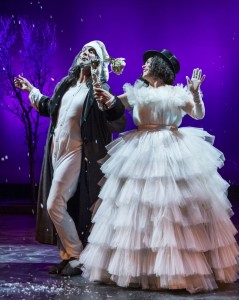 improving our quality of life, and allowing us to select the exact product we want for the lowest price possible, the quality of life has improved, but the satisfaction with life has diminished greatly, conversely. As a small snapshot: Black Friday and Cyber Monday netted sales of $3 billion in the United States alone. Alas, here in the land of the free and home of the brave, Christmas has become more focused on the accumulation of things and the art of the deal than it is about the celebration of Jesus’ birth and the hope, joy, charity, and love we are called to share with one another. A Noise Within’s timely production of Carol squanders the opportunity to deliver the accessible parable in a powerful fashion because much like the commercialization of Christmas itself, directors Julia Rodriguez-Elliott and Geoff Elliott focus more attention to the dressings and decorations of the affair and not enough attention on the heart and soul of the piece.
improving our quality of life, and allowing us to select the exact product we want for the lowest price possible, the quality of life has improved, but the satisfaction with life has diminished greatly, conversely. As a small snapshot: Black Friday and Cyber Monday netted sales of $3 billion in the United States alone. Alas, here in the land of the free and home of the brave, Christmas has become more focused on the accumulation of things and the art of the deal than it is about the celebration of Jesus’ birth and the hope, joy, charity, and love we are called to share with one another. A Noise Within’s timely production of Carol squanders the opportunity to deliver the accessible parable in a powerful fashion because much like the commercialization of Christmas itself, directors Julia Rodriguez-Elliott and Geoff Elliott focus more attention to the dressings and decorations of the affair and not enough attention on the heart and soul of the piece.
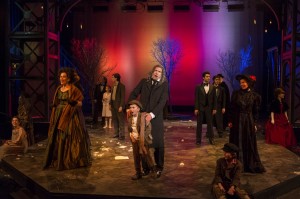 For those few still uninitiated or have simply forgotten, A Christmas Carol is the Dickens story where soulless, money-minded miser Ebenezer Scrooge takes a time-traveling journey with the aid of three ghosts (Christmas Past, Christmas Present, and Christmas Future, respectively). Throughout the course of the journey, Scrooge is confronted with his past mistakes, the present situations of his family, friends, and associates, and the future awaiting all involved. After all this, Scrooge finds himself on the brink of life and death; is he damned and lost for all time or will he find salvation through the transformation of his soul?
For those few still uninitiated or have simply forgotten, A Christmas Carol is the Dickens story where soulless, money-minded miser Ebenezer Scrooge takes a time-traveling journey with the aid of three ghosts (Christmas Past, Christmas Present, and Christmas Future, respectively). Throughout the course of the journey, Scrooge is confronted with his past mistakes, the present situations of his family, friends, and associates, and the future awaiting all involved. After all this, Scrooge finds himself on the brink of life and death; is he damned and lost for all time or will he find salvation through the transformation of his soul?
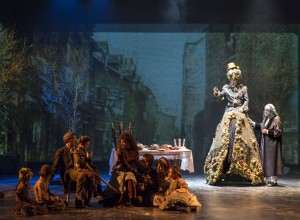 Geoff Elliott’s faithful adaptation of the novella moves briskly with a running time of ninety minutes. And yes, the question naturally arises: If the adaptation is faithful to the source material, how is it that not enough attention is spent on the heart and soul of the piece? The answer: Hollow interpretation and weak realization of the characters. First and foremost offender of such is the production’s co-director, adapter, and star Geoff Elliott as the iconic Ebenezer Scrooge. Mr. Elliott is usually reliable delivering full-bodied, stirring portrayals of characters on stage; however, his Scrooge is lacking. His Scrooge is not miserly, but crotchety, penny-pinching instead of greedy, difficult instead of despicable. Frequently annoyed by the suggestions of charity giving, invitations to parties, or an employee asking to take the day off to celebrate a widely-recognized holiday with his family; he is presented as a shrewd, irritable tightwad. Yet, the deeper truth of the character and the meatier portrayal requires that he be a despicable wretch fueled by greed, nurtured by misery, and rotten cynicism reeking with every word he utters. The way Mr. Elliott portrays Scrooge, he is more keen to negotiate his existence with the spirits than find true redemption of his soul. Because of this, the climax of the play becomes compromised by the tepid and overly jokey characterization that ultimately robs the pay-off from resonating deeply with the audience.
Geoff Elliott’s faithful adaptation of the novella moves briskly with a running time of ninety minutes. And yes, the question naturally arises: If the adaptation is faithful to the source material, how is it that not enough attention is spent on the heart and soul of the piece? The answer: Hollow interpretation and weak realization of the characters. First and foremost offender of such is the production’s co-director, adapter, and star Geoff Elliott as the iconic Ebenezer Scrooge. Mr. Elliott is usually reliable delivering full-bodied, stirring portrayals of characters on stage; however, his Scrooge is lacking. His Scrooge is not miserly, but crotchety, penny-pinching instead of greedy, difficult instead of despicable. Frequently annoyed by the suggestions of charity giving, invitations to parties, or an employee asking to take the day off to celebrate a widely-recognized holiday with his family; he is presented as a shrewd, irritable tightwad. Yet, the deeper truth of the character and the meatier portrayal requires that he be a despicable wretch fueled by greed, nurtured by misery, and rotten cynicism reeking with every word he utters. The way Mr. Elliott portrays Scrooge, he is more keen to negotiate his existence with the spirits than find true redemption of his soul. Because of this, the climax of the play becomes compromised by the tepid and overly jokey characterization that ultimately robs the pay-off from resonating deeply with the audience.
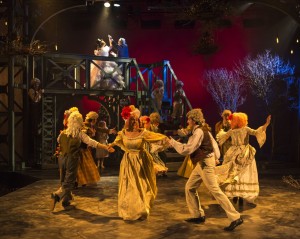 Robertson Dean’s turn as the narrator is detached at the start, but he eventually finds the warm, graceful rhythm necessary as the piece carries on. Deborah Strang’s interpretation of the Ghost of Christmas Past is sumptuous and ethereal, her turn as the charwoman is appropriately cheeky with sinister undertones. Alan Blumenfeld’s Ghost of Christmas Present is pleasantly jocular and jovial, but misses the mark by not fully committing to a serious tone when he uses Scrooge’s cold-hearted retorts to reproach Scrooge. Mitchell Edmonds is wonderfully wounded and weighted in his portrayal of Marley, and a clever curmudgeon as Old Joe, but his interpretation as Fezziwig lacks the joy, pep, and stark contrast to Scrooge the role demands. Stephen Rockwell gives a one-note performance as Bob Cratchit; he plays his character as a man beaten by his environment and employer. He rarely expresses the happiness or cheerfulness he supposedly inspires his children with. Jill Hill miscalculates with her angry and vindictive portrayal of Mrs. Cratchit that denies the audience to empathize or connect with her smart but poorly delivered sentiments. Alison Elliott’s turn as Scrooge’s lost love Belle laces her admonition to Scrooge with too much spurn and not enough love. Rafael Goldstein is delightfully affable as Fred, but brings little dimension to Scrooge as a younger man. The older children in the ensemble (Brendan Haley and Georgia Miller) perform better than the younger ones (Jack Elliott, Dámaso J. Rodriguez, and Marie Sullivan); the older children make better sense of the text and don’t drop their endings. The Ghost of Christmas Future (Kevin Rico Angulo) is bizarrely re-imagined as a sort of Sasquatch mixed with a wintry tree. The results are distracting and unrewarding because it perverts Dickens’ use of the Reaper-like character to indicate the eventual finality that awaits us all: it’s a commentary about facing the inevitable, but this production decides to make it a commentary about death.
Robertson Dean’s turn as the narrator is detached at the start, but he eventually finds the warm, graceful rhythm necessary as the piece carries on. Deborah Strang’s interpretation of the Ghost of Christmas Past is sumptuous and ethereal, her turn as the charwoman is appropriately cheeky with sinister undertones. Alan Blumenfeld’s Ghost of Christmas Present is pleasantly jocular and jovial, but misses the mark by not fully committing to a serious tone when he uses Scrooge’s cold-hearted retorts to reproach Scrooge. Mitchell Edmonds is wonderfully wounded and weighted in his portrayal of Marley, and a clever curmudgeon as Old Joe, but his interpretation as Fezziwig lacks the joy, pep, and stark contrast to Scrooge the role demands. Stephen Rockwell gives a one-note performance as Bob Cratchit; he plays his character as a man beaten by his environment and employer. He rarely expresses the happiness or cheerfulness he supposedly inspires his children with. Jill Hill miscalculates with her angry and vindictive portrayal of Mrs. Cratchit that denies the audience to empathize or connect with her smart but poorly delivered sentiments. Alison Elliott’s turn as Scrooge’s lost love Belle laces her admonition to Scrooge with too much spurn and not enough love. Rafael Goldstein is delightfully affable as Fred, but brings little dimension to Scrooge as a younger man. The older children in the ensemble (Brendan Haley and Georgia Miller) perform better than the younger ones (Jack Elliott, Dámaso J. Rodriguez, and Marie Sullivan); the older children make better sense of the text and don’t drop their endings. The Ghost of Christmas Future (Kevin Rico Angulo) is bizarrely re-imagined as a sort of Sasquatch mixed with a wintry tree. The results are distracting and unrewarding because it perverts Dickens’ use of the Reaper-like character to indicate the eventual finality that awaits us all: it’s a commentary about facing the inevitable, but this production decides to make it a commentary about death.
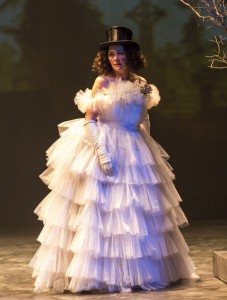 Jeanine A. Ringer’s scenic design is impressively concocted as sets of a workplace, warehouse, bedroom, ballroom, cramped dining room, a seedy meeting place for thieves, and cold, wintry streets are all striking and sparse yet well-defined. The costumes by Angela Balogh Calin are excellent with the ghosts’ costumes being the most stunning; Deborah Strang’s billowy white dress as the Ghost of Christmas Past, Alan Blumenfeld’s Carmen Miranda inspired fruit-covered long garb, and though it doesn’t fit the piece best, the costume of the Ghost of Christmas Future is impressive with its tree branches and shadowy, fringed dressing. Ego Plum’s music and sound design are pleasant and effective, respectively. The sound design for Marley’s ghost stands out especially for its haunting, moaning banshee sound. Ken Booth’s lighting design shifts colors and tones like a mood ring and illuminates each scene with the appropriate palette.
Jeanine A. Ringer’s scenic design is impressively concocted as sets of a workplace, warehouse, bedroom, ballroom, cramped dining room, a seedy meeting place for thieves, and cold, wintry streets are all striking and sparse yet well-defined. The costumes by Angela Balogh Calin are excellent with the ghosts’ costumes being the most stunning; Deborah Strang’s billowy white dress as the Ghost of Christmas Past, Alan Blumenfeld’s Carmen Miranda inspired fruit-covered long garb, and though it doesn’t fit the piece best, the costume of the Ghost of Christmas Future is impressive with its tree branches and shadowy, fringed dressing. Ego Plum’s music and sound design are pleasant and effective, respectively. The sound design for Marley’s ghost stands out especially for its haunting, moaning banshee sound. Ken Booth’s lighting design shifts colors and tones like a mood ring and illuminates each scene with the appropriate palette.
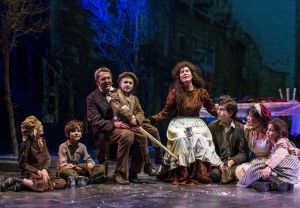 What is most disappointing about the production is that in spite of its exceptional staging, delicious decorations, and clever trickery (including Marley’s chains extending from a balcony and others from the ceiling) it is for naught. These elements are overshadowed by the overall mediocrity of the actors’ performances. This is aggravating because this piece is done so often, one would think a classical theatre company would be able to deliver that element, above all others, especially well. Therein the credit lies with co-directors (and Producing Artistic Directors) Geoff Elliott and Julia Rodriguez-Elliott for presenting a richly realized world, full of poorly realized characters.
What is most disappointing about the production is that in spite of its exceptional staging, delicious decorations, and clever trickery (including Marley’s chains extending from a balcony and others from the ceiling) it is for naught. These elements are overshadowed by the overall mediocrity of the actors’ performances. This is aggravating because this piece is done so often, one would think a classical theatre company would be able to deliver that element, above all others, especially well. Therein the credit lies with co-directors (and Producing Artistic Directors) Geoff Elliott and Julia Rodriguez-Elliott for presenting a richly realized world, full of poorly realized characters.
photos by Craig Schwartz
Charles Dickens’ A Christmas Carol
A Noise Within in Pasadena
scheduled to end on December 23, 2012
for tickets, call 626-356-3100 or visit A Noise Within
